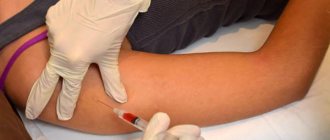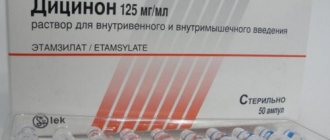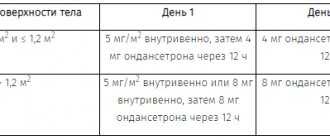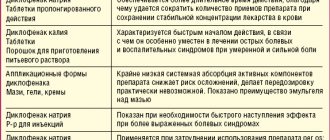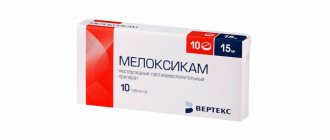CONTRAINDICATIONS Individual intolerance to the drug. Severe renal failure (creatinine clearance less than 30 ml/min). Autoimmune diseases. Pregnancy and breastfeeding, children under 18 years of age.
PRECAUTIONS FOR APPLICATION Disorders of the liver and biliary tract. Renal and urinary tract disorders. Since liver and kidney function is usually reduced in elderly people, the drug Neovir® should be prescribed with caution.
USE IN PREGNANCY AND BREASTFEEDING The safety of using Neovir® during pregnancy and breastfeeding has not been studied, therefore the drug is contraindicated for use during pregnancy and breastfeeding.
METHOD OF APPLICATION AND DOSES The injection solution is administered intramuscularly, a single therapeutic dose is 250 mg (1 ampoule) or 4-6 mg per kg of patient body weight. If necessary, a single dose of Neovir® can be increased to 500 mg.
The course of treatment, unless there are special instructions, consists of 5 - 7 intramuscular injections of the drug Neovir® at a dose of 250 mg with an interval of 48 hours, the course dose depends on the clinical picture. Course duration is 9 - 13 days. A single prophylactic dose is 250 mg (1 ampoule) or 4-6 mg per kg of body weight.
For HIV infection, Neovir® injection solution is used in combination with specific antiviral drugs. The course of treatment consists of 10 injections of 250 mg with an interval between injections of 48 hours. After the course they take a break of 2 months. It is possible to use repeated courses according to indications.
For long-term use, the recommended interval between administrations of the drug Neovir® is 3 - 7 days.
SIDE EFFECTS On the skin and subcutaneous tissues: rash. Very rare - 1/10000 prescriptions (<0.01%).
From the immune system: hypersensitivity reactions, including anaphylactic reactions, increased body temperature. Very rare - 1/10000 prescriptions (<0.01%).
General and injection site disorders: injection site reactions, including pain at the injection site, may occur. Very rare - 1/10000 prescriptions (<0.01%).
OVERDOSE Cases of overdose of Neovir® have not been described.
INTERACTION WITH OTHER MEDICINES Pharmaceutical: in all studies of the drug Neovir®, no physicochemical interactions or other types of undesirable interactions were identified.
SPECIAL INSTRUCTIONS In case of poor tolerance or pain at the injection site, it is recommended to administer the drug Neovir® together with a local anesthetic solution (2 ml of 0.25 - 0.5% procaine solution). It is first necessary to conduct a skin test for sensitivity to the anesthetic used.
INFLUENCE ON THE ABILITY TO DRIVE VEHICLES AND MECHANISMS There is no information regarding the effect of the drug on reaction speed when driving vehicles and engaging in other potentially hazardous activities that require increased concentration and speed of psychomotor reactions.
Neovir
Instructions for use:
NEOVIR®
Registration number
P N003311/01.
Chemical name.
Sodium 2-(9-oxo-9,10-dihydroacridin-10-yl) acetate.
INN.
Sodium oxodihydroacridinyl acetate.
Dosage form.
Solution for intramuscular administration.
Compound.
1 ml of solution contains:
Active ingredient:
Oxodihydroacridine or sodium acetate (Neovir®) -125 mg.
Excipients:
sodium citrate - 2.5 mg; citric acid monohydrate - 0.5-1.5 mg (up to pH 7.5-8.3); water for injection - up to 1 ml.
Description.
Transparent liquid of greenish-yellow color.
Pharmacotherapeutic group.
Immunostimulating agent, immunomodulator.
ATX code:
L03A.
Pharmacological properties.
Pharmacodynamics.
The drug has an antiviral effect against DNA and RNA genomic viruses. Has a pronounced anti-chlamydial effect.
Neovir causes a rapid increase in titers of endogenous interferons α, β and γ, especially interferon-α. The administration of 250 mg of Neovir intramuscularly, based on detectable serum interferon concentrations, is equivalent to the administration of 6-9 million IU of recombinant interferon-α. The peak activity of interferons in the blood is observed after 1.5-2 hours and persists for 16-20 hours after the administration of Neovir. As a result, a cascade of immune reactions is induced in the body, aimed at the destruction and elimination of pathogens and cells affected by them. Interferon-producing cells acquire the ability to enhance the production of interferon in response to repeated induction caused by a pathological agent; this property persists for a long time after discontinuation of the drug.
The immunomodulatory effect is due to Neovir’s ability to activate hematopoietic stem cells, normalize the balance of T-lymphocyte subpopulations, and stimulate the effector parts of the immune system. Neovir has a pronounced stimulating effect on the functional activity of macrophages and polymorphonuclear leukocytes, enhancing their migration and phagocytic activity.
Neovir corrects the pathology of tissue growth, activates NK cells, enhances all forms of cytotoxicity, affects the restoration of cell adhesiveness, and inhibits their proliferative and metastatic activity.
Pharmacokinetics.
When administered intramuscularly, the bioavailability of Neovir is more than 90%. After administration of 100-500 mg of Neovir, the maximum concentration in plasma is reached after 15-30 minutes and is 8.3 μl/ml. After 5 hours, only small amounts of Neovir are detected; after 6 hours, Neovir is not detected in the blood plasma.
Neovir is excreted from the body unchanged by the kidneys, without being metabolized, with a half-life of 1 hour. 15-30 minutes after the administration of Neovir, serum interferon titers begin to increase in the plasma. 2 peaks of interferon content in plasma were detected: 70 IU/ml after 1.5-2 hours and 110 IU/ml after 8-10 hours, after which the interferon content begins to decrease. After 24 hours, the concentration of serum interferons remains quite high, returning to initial values 46-48 hours after administration.
Indications for use.
Treatment (as part of combination or monotherapy):
· influenza and other acute respiratory viral diseases, including against the background of immunodeficiency states;
· infections caused by the Herpes Simplex virus, Varicella Zoster, Herpes Simplex Genitalis, including in persons with immune system disorders:
· cytomegalovirus infection in people with immunodeficiency;
· radiation immunodeficiency;
· HIV infection;
· encephalitis and encephalomyelitis of viral etiology;
· acute and chronic hepatitis B and C;
· urethritis, epididymitis, prostatitis, cervicitis and salpingitis of chlamydial etiology;
· lymphogranuloma venereum;
· oncological diseases;
multiple sclerosis;
Candidal lesions of the skin and mucous membranes;
papillomavirus infection.
Prevention
influenza and other acute respiratory viral diseases.
Contraindications. Individual intolerance to the drug. Severe renal failure (creatinine clearance less than 30 ml/min). Autoimmune diseases, pregnancy and lactation, childhood.
Carefully.
Elderly age.
Method of administration and dose.
The injection solution is administered intramuscularly, a single therapeutic dose is 250 mg (1 ampoule) or 4-6 mg per kg of patient body weight. If necessary, a single dose of Neovir can be increased to 500 mg.
The course of treatment, unless there are special instructions, consists of 5-7 intramuscular injections of Neovir at a dose of 250 mg with an interval of 48 hours, the course dose depends on the clinical picture. Course duration is 8-12 days. The prophylactic dose is 250 mg (1 ampoule) or 4-6 mg per kg of body weight. For long-term use, the recommended interval between administrations of Neovir is 3-7 days.
For HIV infection, Neovir solution for injection is used in combination with specific antiviral drugs. The course of treatment consists of 10 injections of 250 mg with an interval between injections of 48 hours. After the course they take a break of 2 months. It is possible to use repeated courses according to indications.
Side effect. Low-grade fever, allergic reactions. Local, quickly passing pain at the injection site. In case of poor tolerance or pain at the injection site, it is recommended to administer Neovir together with a local anesthetic solution.
Overdose.
There are no cases of Neovir overdose described.
Use during pregnancy and breastfeeding.
The safety of using Neovir during pregnancy and lactation has not been studied, therefore the drug is contraindicated for use.
Interaction with other drugs.
No physical-chemical incompatibility or other types of undesirable interactions were identified.
Special instructions.
There is no information about the possibility of a negative effect of the drug on the performance of potentially hazardous activities that require special attention and quick reactions (driving a car and other vehicles, working with moving mechanisms, working as a dispatcher and operator, etc.).
Release form.
Solution for intramuscular administration 250 mg/2 ml in light-protective glass ampoules of 2 ml, 3.5 ampoules in a blister pack made of polyvinyl chloride film. 1-blister packaging with instructions for medical use in a cardboard pack.
Best before date.
3 years. Do not use the drug after the expiration date.
Storage conditions.
In a dry place, protected from light and out of reach of children, at a temperature of 15-25°C. Cloudiness of the Neovir solution to a milky white color indicates a violation of storage conditions and unsuitability for use.
Conditions for dispensing from pharmacies.
By doctor's prescription.
, Experimental production of medical and biological preparations of the Federal State Institution “Russian Cardiology Research and Production Complex”, Russia.
www.pharmsynthez.com
Detailed description of regimens for using Neovir for various diseases
INFECTIONS CAUSED BY HERPES VIRUSES
The relevance of the herpes problem lies in the extremely wide prevalence of herpes viruses among people (70% of children after the first 3 years of life have antibodies to the HSV-1 virus and 80-90% of adults have antibodies to HSV-2) and the ability of herpes viruses to affect all organs and systems in the form of acute, latent and chronic recurrent infections. Recently, clinicians have been paying attention to the role of herpes viruses in the development of pregnancy pathologies, cervical cancer and prostate cancer, as well as their possible role in the development of atherosclerosis. The number of patients hospitalized in various hospitals for herpes infection reaches 1.5-2 million a year in Russia. It has been established that despite the polymorphism of the clinical manifestations of herpes infection, the etiology of primary infection, persistence and recurrence lies in the suppression of interferon production and a decrease in T-cell immunity. In severe, often recurrent forms of herpes infection, NEOVIR effectively normalizes the level of a-TNF, the decrease of which correlates with the severity of the disease. Therapy with NEOVIR allows you to effectively influence these and other immunopathological links in the development of herpes infection and cause a clinical effect of therapy. METHOD OF APPLICATION AND DOSES In the acute period of herpes infection, it is recommended to start with 2 injections (depending on the severity 250-500 mg) with an interval of 24 hours and then 3 more injections with an interval of 48 hours. In severe cases of herpes infection, combination therapy with NEOVIRPM and acyclovir is recommended. When purulent bacterial flora is attached, the combination of NEOVIR and antibiotics is highly effective, leading in most cases to the rapid disappearance of fever, symptoms of purulent intoxication and relief of the process. In the inter-relapse period, 1 injection per week at a dose of 250 mg is recommended to consolidate the clinical effect and maintain antiviral resistance. After a month's course, it is recommended to take a break for 4-5 weeks.
UROGENITAL CHLAMYDIOSES, MYCO- AND UREAPLASMOSIS
A serious health problem is the global uncontrolled spread of chronic urogenital infections (UGI). UGI caused by these microorganisms is the most common sexually transmitted disease, as well as a common etiological cause of chlamydia in other localizations and urogenic Reiter's syndrome. Their important feature is a long relapsing course and low sensitivity to antibiotic therapy. associated with the inferiority of the immune response, antigenic masking caused by the introduction of a microorganism into the cell membrane or obligate intracellular parasitism. It manifests itself primarily in the classic phenomenon of “incomplete phagocytosis”, a decrease in the phagocytic activity of polymorphonuclear leukocytes, the helper/suppressor ratio and other known laboratory abnormalities. It has been proven that the use of NEOVIR in combination with antibiotics led to the etiological cure of chronic urogenital chlamydia in 92-100% of cases (observation period 6 months after the end of therapy). It is significant that these indicators were achieved in patients who underwent one to four courses of treatment for chlamydia, which turned out to be ineffective. The use of the most sensitive diagnostic methods, such as PCR, shows that traditionally used methods of treating myco- and ureaplasma infections are also unsatisfactory. The use of NEOVIR makes it possible to increase etiological cure rates by 32% compared to the control, where traditionally used immunomodulators (thymogen) were used. (Bogatyreva and others). There is good tolerability of long courses of antibiotics with the use of NEOVIR, which is expressed in a sharp decrease or even complete absence of subjective signs of drug intoxication and the rare development of dysbiosis. which allows you to significantly reduce the cost of treatment due to bacterial drugs, antimycotic drugs and hepatoprotectors. METHOD OF APPLICATION AND DOSES A course of 5-7 injections of 250 mg is recommended, with an interval of 48 hours. Antibiotics in recommended course doses begin to be taken on the day of the second injection of NEOVIR. At the end of the course of antibacterial therapy, a course of 5 injections according to the same regimen is recommended. In mild cases with low DNA titers in prostatic secretions, scrapings from the urethra and cervix, monotherapy with NEOVIR is possible with a course of 10 injections every 48 hours.
CHLAMYDIOSES OF OTHER LOCATIONS
In addition to chlamydia caused by C. trachomatis, which usually occurs in the form of urogenital infections, in recent years there has been an increase in acute and chronic infections caused by C. psittaci, C. pneumoniae, which may be due to better diagnosis of these diseases. In Moscow, ornithosis is detected in 18.4% of patients with acute pneumonia, in St. Petersburg - 19.6%. Its characteristic feature is the frequent transition to a chronic form, manifested by periodic exacerbations, occurring both in the form of recurrent diseases of the upper respiratory tract and lungs, and atypical variants of ornithosis meningitis (occurring under various masks, up to multiple sclerosis), typhoid-paratyphoid form, etc. etc. Diseases caused by C. pneumoniae also have a high proportion. The combination of NEOVIR with antibacterial therapy has been proven to be highly effective. Both on the example of primary and previously unsuccessfully treated patients for undiagnosed forms of chronic respiratory tract lesions. Taking into account the sensitivity of chlamydia, sumamed, rovamycin, and rulide were used in therapeutic doses with a change in antibiotic. With the ongoing treatment, it is possible to reduce the percentage of relapses from 21 to 0.8%. METHOD OF APPLICATION AND DOSES A course of at least ten injections at a dose of 250 mg IM every 48 hours is recommended. Antibiotics are started on the day of the second NEOVIR injection.
CANDIDIA AND BACTERIAL CANDIDIA DISEASES OF THE SKIN, MUCOUS MEMBRANES AND INTERNAL ORGANS.
Diseases of candidiasis and combined candidiasis-bacterial etiology are mainly an ethnic manifestation of primary and secondary immunodeficiencies of various origins. They often occur as a complication of antibacterial, immunosuppressive, cytostatic and radiation therapy. Monotherapy with NEOVIR led to a marked improvement in the clinical condition, the disappearance of typical plaques and rashes, and a reduction in specific symptoms against the background of normalization of immunological parameters. Clinical improvement was confirmed by mycological research methods. NEOVIR can also be used as part of combination therapy in combination with antifungal drugs. METHOD OF APPLICATION AND DOSES A course of 10-12 injections of 250 mg with an interval of 3 days is recommended.
VIRAL HEPATITIS
The primary incidence of acute viral hepatitis in Russia is over 500 thousand people per year. At the same time, the lack of effective antiviral drugs that do not have a negative effect on liver function leaves the question of their etiological treatment open. Active interferon therapy for chronic forms allows achieving remission in approximately 35-40% of patients lasting up to a year. Cases of cure are extremely rare (no more than 8%-12%). The use of NEOVIR in volunteers did not reveal any suppressive effect of the drug on liver function. The drug also does not undergo any metabolic processing in hepatocytes. In acute viral hepatitis A, the use of NEOVIR causes rapid relief of hepatocytolytic syndrome, which is associated with the active suppression of viral replication in sensitive cells. When NEOVIR was included in the usual treatment regimen for acute viral hepatitis B and C, there was a pronounced decrease in the time of convalescence, acceleration of normalization of biochemical parameters by 1-1.7 times, which led to a significant reduction in the patient’s time in hospital, and the percentage of patients with antigenemia after a course of treatment decreased . In the fulminant form of acute viral hepatitis, the prescription of NEOVIR is justified only in the immunotolerant (replicative) variant, when seroconversion does not occur in a precomatous state (10-15% of patients with the fulminant form). In such cases, the combined use of NEOVIR and -interferon and high doses of nucleoside drugs, such as acyclovir (only for viral hepatitis B) is justified. In the case of high-volume plasmapheresis, the drug is used only after its completion. In the hyperimmune variant of the fulminant form, NEOVIR is contraindicated. In general, signs of severe cholestasis correlate with an insufficient response to NEOVIR therapy. A combination with ursodeoxycholic acid is advisable. An important clinical effect of NEOVIR is its ability to prevent the formation of chronic forms of the disease in groups of patients with an increased risk of chronic infection in hepatitis B and C. For chronic hepatitis B and C with proven activity of the HBV viruses (HBV DNA and HBe antigen) and HCV ( HCV RNA) long-term use of NEOVIR suppresses the activity of the virus in affected cells and promotes its elimination. It was found that despite a significant increase in the level of interleukin-1 (2.5 times compared to healthy people), in patients with viral hepatitis. The level of interleukin-2 (IL-2) was reduced almost threefold. IL-2 is the leading agent involved in the formation of cell-type reactions in antiviral immunity (cytotoxic T lymphocytes). Under the influence of NEOVIR, the ability to induce IL-2 reliably increases by more than 2 times and practically reaches that of healthy people. It should be noted that this result is achieved with a single exposure. When treated with NEOVIR, both the protection of intact hepatocytes through the action of endogenous interferons and cytolytic aggression against virus-infected cells are enhanced, which is manifested by an increase in the level of cytolysis markers in approximately 50% of patients. A clear increase in ALT at 8-12 weeks of therapy has a favorable prognostic value (Regrillo R. R., 1993, cited by Sorinson S. N. “Viral hepatitis in clinical practice,” p. 148. St. Petersburg. Teza, 1996.) and is not a contraindication for further use of the drug. METHOD OF ADMINISTRATION AND DOSES For acute viral hepatitis, injections of NEOVIR 250 mg are recommended every 48 days for 2-3 weeks or until seroconversion. To strengthen the effect, it is recommended that 5-6 more injections of 250 mg each be administered over the course of a month. When treating protracted forms, 250 mg three times a week for at least 2.5 months. For chronic active hepatitis B, it is recommended to prescribe NEOVIR 3 times a week, 250 mg for 2-4 months. The appearance of anti-HBe antibodies with a decrease in the level of genomic markers of viral replication is an indicator of a good clinical effect. Combination with courses of acyclovir is pathogenetically justified. In the absence of laboratory and/or clinical effect after 2 months of therapy, further continuation of treatment with Neovir is not advisable. Neovir for chronic hepatitis C should be prescribed 250 mg three times a week for at least 3 months. An increase in alanine transferase levels after 8-12 weeks of treatment indicates a favorable prognosis. During treatment, it is desirable to monitor the replicative activity of the virus using PCR. Achieving remission for up to a year with chronic vir. hepatitis is regarded as a good result of therapy with NEOVIR. The number of repeat courses is not limited.
RESPIRATORY VIRAL INFECTIONS AND FLU
NEOVIR is used in the treatment of respiratory infections caused by parainfluenza viruses, rhinovirus, RSV virus, adenoviruses and influenza virus, for the prevention of naturally occurring (secondary) immunodeficiency, as well as for the treatment of primary immunodeficiency, manifested by frequent acute respiratory diseases. It is recommended to start therapy with NEOVIR at the earliest stages of the disease, which allows achieving maximum clinical effect. NEOVIR is also recommended to be used as a prophylactic agent in the presence of a threat of infection. METHOD OF APPLICATION AND DOSES For therapeutic purposes, it is recommended from one injection of 250 mg (effective in the early stages of influenza or acute respiratory infections) to four injections with an interval of 48-36 hours (depending on the severity of the disease). For prophylactic use, one injection of 250 mg is recommended. Repeat every 2-3 days until the threat of infection disappears, but no more than 5 injections.
MUMPS
In recent decades, there has been a pronounced “maturation” of childhood infections; in particular, epidemic outbreaks of viral parotitis are observed almost every year among schoolchildren at graduation and conscripts. In the pathogenesis of viral mumps, important links are viremia and glandular tropism. and to a lesser extent, nervous tissue. The severity of the pathology is primarily determined by the severity of complications and their high frequency. In recent years, they have become meningitis (about 10% of patients), persistent hearing loss, and orchitis. Given that involvement of the parotid gland does not necessarily precede complications, late diagnosis and late prescription of corticosteroids are possible. In this case, orchitis in 50% of cases ends within a few months with testicular atrophy up to azoospermia. Therapy with NEOVIR, like (a-interferons), is effective only in the very early stages of the disease, but it has a pronounced preventive effect in the epidemic focus. The use of NEOVIR according to the developed regimen reduces the percentage of complicated forms, and long-term studies reveal that during NEOVIR therapy, glandular inflammations become benign, which significantly reduces the percentage of late andrological complications. METHOD OF APPLICATION AND DOSES NEOVIR is administered to patients with moderate and severe mumps, admitted no later than 3 days from the onset of the disease, upon admission at a dose of 500 mg IM, then 250 mg IM after 24 hours, then from two to 7′ injections per dose of 250 mg once every 48 hours.
TUMOR DISEASES
In patients with cancer of various locations in advanced stages (T3-T4 M+), the use of NEOVIR led to clinical stabilization of the process and an increase in life expectancy. The effect was accompanied by an improvement in well-being and an increase in the quality of life of patients. This effect of the drug is associated with its ability to activate anti-cancer components of the immune system - natural killer cells (NK cells) and cytotoxic T lymphocytes, while inhibiting the production of tumor necrosis factor (TNF). The role of endogenous α-interferon induced by NEOVIR in the antitumor effect of the drug is being studied. It is assumed that this is due to the good sensitivity to NEOVIR therapy for such tumors as renal cell carcinoma with relapses and metastases, and advanced melanoma. The effectiveness of NEOVIR has been shown in patients with advanced breast cancer (T 1-4 N 1-X M 1-X) in menopause with acquired resistance to a previously effective anti-estrogen (tamoxifen). A month's course of treatment with NEOVIR while continuing to take tamoxifen led to clinical stabilization or partial remission in 70% of cases. The effect of NEOVIR is associated with the enhancement by endogenous interferons of the expression of progestin and estrogen receptors in receptor-positive breast cancer cells and the elimination of the receptor-negative pool. The effectiveness of NEOVIR in this group of patients is being studied when prescribing longer and repeated courses of the drug, as well as when prescribing antiestrogens and NEOVIR together as first-line hormone therapy in patients with advanced breast cancer in menopause with a positive or unknown receptor status of tumor cells.
Currently, the effectiveness of NEOVIR has been studied and is being studied* in the following cases:
| EFFECTIVE MECHANISM | DISEASE | APPLICATION OPTIONS | ||
| Antiproliferative and receptor-inducing effects of endogenous a-interferon | Mammary cancer | In combination with antiestrogens (tamoxifen, torymifene) for stage III-IV inoperable cancer. | ||
| Cytostatic, anti-invasive and antimetastatic effect of endogenous a-interferon | Kidney cancer Melanoma T-cell cutaneous lymphomas Hairy cell leukemia Chronic myeloid leukemia | ·*Monotherapy as a choice in stages III-IV ·*As part of combination and complex therapy in earlier stages ·*As a component of adjuvant and non-adjuvant therapy. | ||
| Modification of chemotherapy drug metabolism by interferons | Advanced colon cancer Advanced rectal cancer | In combination with 5-fluorouracil | ||
| Anti-cachexic effect | Common cancer of the lung, stomach and other organs | *As a component in a palliative treatment regimen for inoperable cases of cancer | ||
P
ri inoperable. In locally advanced or disseminated breast cancer with emerging resistance to the previously effective tamoxifen, NEOVIR is prescribed in one to two-month courses of 250 mg 2 times a week with continued administration of the antiestrogen (tamoxifech) in the same doses during and after completion of the NEOVIR course. The break between NEOVIR courses is 1-2 months. Renal cell cancer and melanoma - 500 mg twice a week. The duration of the course is not limited. T-cell lymphomas, hairy cell leukemia, chronic myeloid leukemia - three times a week, 250-500 mg for 18-20 months. For advanced colon (rectal) cancer, NEOVIR is used in courses of 250 mg. IM 3 times a week, fluorouracil 500 mg/m onto the body surface IV once a week for 4 weeks. If fluorouracil is well tolerated and there is no progression, fluorouracil administration can be continued for up to 8 weeks. As part of complex and combined cancer therapy and as an immunocorrective and immunostimulating agent, NEOVIR is prescribed in courses of 250 mg two to three times a week for 2 months. As a means for symptomatic and maintenance monotherapy in patients with cancer in advanced stages T3-T4 M+ NEOVIR is prescribed 250 mg 5-8 injections per month. If necessary, the monthly dose can be increased to 8-10 injections.
